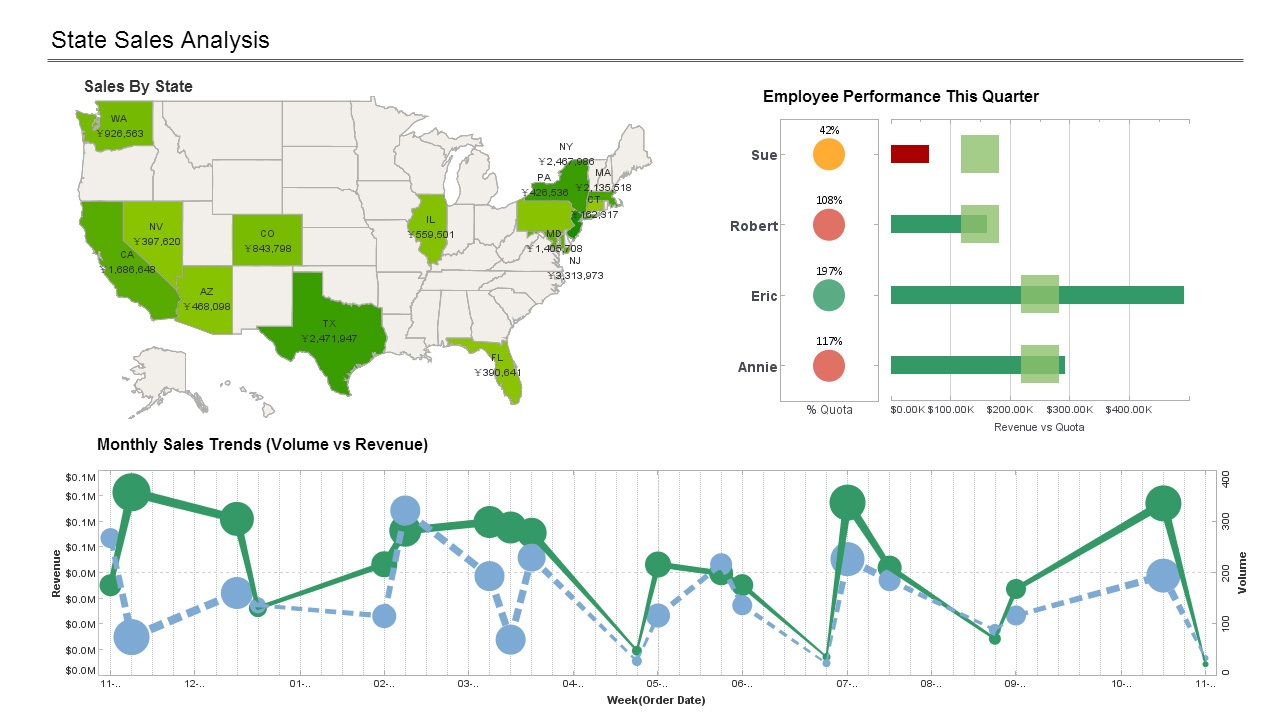External Metrics to Add to Your Scorecard
This is the continuation of the transcript of a Webinar hosted by InetSoft on the topic of "Business Intelligence Agility" The speaker is Mark Flaherty, CMO at InetSoft.
The external metrics that you might think about adding to your scorecard or your dashboard are like weather gauges for a pilot. A pilot can’t control the weather, but they certainly monitor it in order to determine how to fly the plane. So some example external measures might be how your suppliers or vendors are performing, political factors. A pharmaceutical company might be monitoring what’s going on with the healthcare bill and what’s going to happen when it goes into effect. Other external KPI examples are economic factors like housing starts or the price of raw materials or things like that.
Then there are consumer trends. What’s going on in the industry that might impact your organization and finally, what’s going on with your competitors? An external metric might be competitor performance to see are they getting better or worse than us. Maybe our lead is not as much as it used to be.
Here are some other things I’ve seen that are typically not measured on most scorecards but are pretty important. How much do we aggravate our customers? How hard do we make it to do business with us? Most companies have no idea. Try changing your cell phone provider or try changing your cable TV provider. That's a lot of work. Or try refinancing your mortgage. That's a lot of work, a lot of aggravation.
| #1 Ranking: Read how InetSoft was rated #1 for user adoption in G2's user survey-based index | Read More |
Create an Aggravation Index
One delivery company found that their customer survey data didn’t predict customer loyalty so they stopped doing the surveys and started tracking how much they aggravated their customers on a daily basis. They would count things like how many late packages, how many lost packages, how many damaged packages, how many times do people get hung up on in their call center, and how long do they wait on hold. All those things go into the aggravation index and they help predict on a daily basis loyalty from their customers.
Another thing most companies don’t know is how much do we aggravate our employees. Examples are changing policies, changing your office, reorganizing three times in the year, thing like that. External metrics, like I said, typically are not on the scorecard. What’s going on in the world that might devastate us?
Finally a measure that I rarely see is what’s your corporate culture. Everybody has these values that all tend to sound the same and your culture can be a major asset or a major liability. I have worked with some companies that just have a wonderful culture and it’s a big part of their success and there are other companies I’ve worked with that used to have a wonderful culture.
One particular company used to be on the list of the best places to work in America that Fortune does. Years ago, they fell of the list, and most of their long term employees say that it’s just not the kind of culture it used to be. They have totally different values now. So if I were running a company I think I’d want to know that that my culture has moved to the left, and it’s not as good as it used to or if it’s good, that I’m able to maintain it.
 |
View a 2-minute demonstration of InetSoft's easy, agile, and robust BI software. |
When you’re looking at data regardless whether it’s financial data, employee satisfaction, whatever the type of metric is, I think you want to be able to ask these four questions every time. Your level of performance is how am I doing compared to something? That comparison could be last year, a target, or an objective.
A trend is performance over time. If you’re looking at spreadsheets, it’s very hard to see a trend. It’s much better to plot this data on a graph and be able to see it as a trend. Then the owner of the metrics should explain why is this happening. That’s the words behind the numbers. Often the words are a lot more meaningful than just looking at the numbers. Most clients require analysis comments even when performance is good, and the trend is good, because we need to know what did we do that caused this to happen that we’re doing so well. Was it just luck, or is it something that we did? Finally the action plan is what are we doing about it. Either it is focused on improving performance if it’s bad, or maintaining it if it’s good.
Again, I see a lot of action plans being checked off as completed, but performance is still bad, so that tells you that you’ve got a bad analysis and probably a bad action plan so you have to keep revising the action plan to make sure that it’s moving the needle in the right direction.
| Previous: The Difference Between a Singular Measure and an Analytic Measure |


